Review: ‘Small is Beautiful’ exhibit shows the intricacy of miniature art
The much-publicized miniature art exhibit has found its way to New York City. It is currently on view in NoHo.
March 22, 2023
“Small is Beautiful, Miniature Art” initially started as a Europe-exclusive exhibit only on view in London and Paris. But now, with Instagram and Pinterest attracting a mainstream interest in miniature art, the world’s biggest miniature art exhibit has expanded across the Atlantic to Manhattan. This small-scale art requires precise technique and an impressive attention to detail.
As noted in its exhibition book, “Small is Beautiful” is organized into six sections: “Tiny is Funny,” “Mini Art for Maxi Thoughts,” “It’s a Small (Magic) World,” “The Art of Paper,” “Life in Diorama” and “To the Infinite and Beyond.” Each section contains unique approaches to reimagining a smaller-than-life reality through the works of 32 international artists. By categorizing the exhibit into exploratory subsections, the curators create an interactive and otherworldly installation that isn’t always possible with regular-sized art. It’s a way to explore the freedom of imagination through unconventional objects, concepts and mediums.
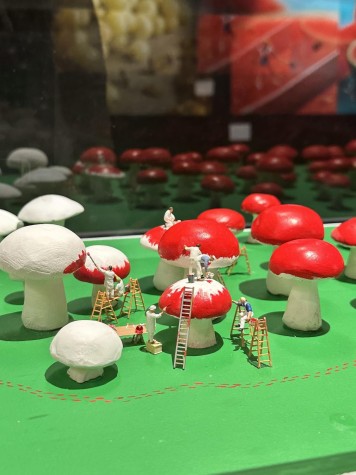
“Tiny is Funny” consists of abstract works that add a comedic element to the artwork’s message. Take “Wet Paint” by Pierre Javelle and Akiko Ida, the pair of artists better known as Minimiam, for example: in their piece, miniature figures are shown climbing up and painting mushrooms to save them from being eaten by real-world humans. Each character is pitching in to the collective effort of coating the mushroom heads in red paint. Some are painted all the way through, while others are still in the process.
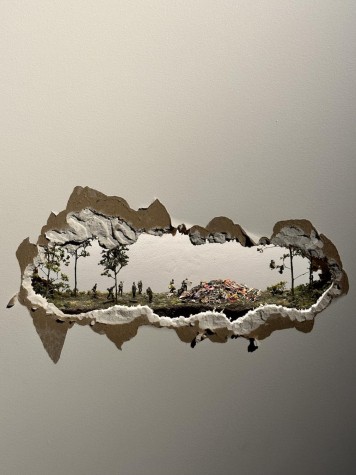
In “Mini Art for Maxi Thoughts,” artists approach scenarios that are too sublime or conceptual to measure. Thomas Doyle’s “You Remember It, or It Remembers You,” part of his “Pass-through Series,” is a collection of miniature art scenarios that are built within a ripped-out part of a wall. According to Doyle, this choice was meant to reflect on the more pressing experiences of life that “may come from the experience of war, either as a combatant or a civilian.” In “You Remember It, or It Remembers You,” miniature soldier figurines are positioned to appear exhausted from piling trash, with some resting on a tree trunk or rock, and others continuing to add to the growing pile of garbage.
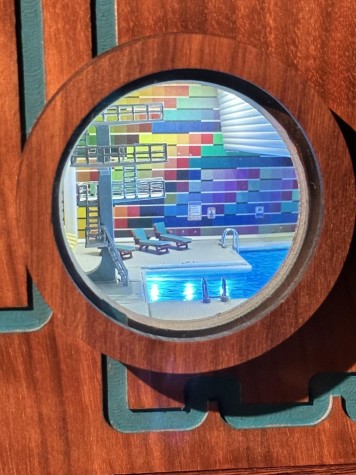
“It’s a Small (Magic) World” is a collection of abstract models that confine life lessons into one alternate reality. None of these works contain human figurines. The curatorial text in Margie Criner’s “Swim” explains how the purpose of the work is to prove that “to ride with the natural direction of things can feel much like swimming.” Looking into the singular circular window of the small box, there is a prosthetic swimming pool, a color-palette for a wall, and beach chairs, all clean and seemingly unused. The serenity of the indoor pool and the absence of human figures add to the notion that this supposed natural direction of life shouldn’t be taken with force. There is a silent beauty to letting life be and noticing the details of one’s surroundings. This is what “Swim” is encapsulating through the indents within the palette wall, the sculpted ripples of pool water and the embedded pool lighting.
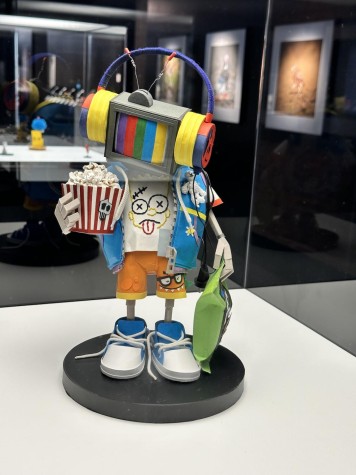
Meanwhile, “The Art of Paper” is a dedication to the art of origami. It carries the wonders of manipulating a plain rectangular piece of paper into something new, with curves, color and dimension. Negar Faal’s origami figurine, “Mr. Migor,” is trippy, colorful and hip. Origami puts an emphasis on edges and angles through the fold of the paper. “Mr. Migor” does this, but also integrates abstraction, vibrant color and modern-day accessories through the folded paper. While the character has a television for a head, all the objects it is carrying have eyes and sharp teeth. None of the components look like the delicate paper material that was used in their construction, however. Instead, the piece gives the illusion of a plastic robot toy.
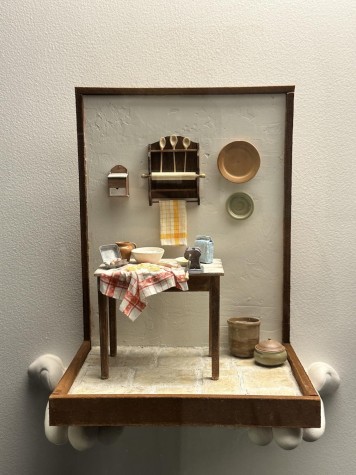
“Life in Diorama” may be a more traditional approach to miniature art, but it is also the most meticulous to execute. Supplies are built to accompany the creation of usable material, but in Le Mini Di Claudia’s “Handmade pasta,” everything created is unusable. The dexterity needed to frame the tablecloth to appear natural and real and to create eggs the size of a fingernail, all within a minuscule unclosed space, though, is unimaginable.
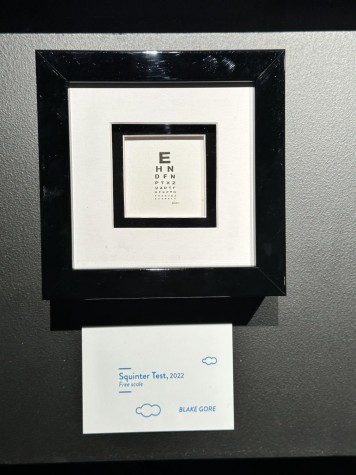
“To The Infinite and Beyond” presents, by far, the smallest miniatures on show in the entire exhibition. The works are so small that magnifying glasses are available nearby for viewers to borrow. The artists make good use of this extreme minuteness, using it as a tool to experiment with irony and humor. Blake Gore’s “Squinter Test” — a depiction of an optotype, or eye test chart — is too small to decipher even if the viewer’s eyes are as near as a couple of centimeters away from the display. Everyone, regardless of their visual ability, is unable to pass the eye test.
Recognizing the detail within art — let alone miniature art — is a reminder for people to slow down and observe the elaborateness of everyday life. The six sections of “Small is Beautiful” show how creativity can be engaging at the smallest scale. Each artist engineers everyday actions, objects and ideas into a minuscule alternate reality with people painting mushroom trees and robot-like origami figurines listening to music. The miniature artwork in “Small is Beautiful” allows viewers to observe the tiniest details, not only in the art, but also what the art is representing — real life.
Contact Afnan Abbassi at [email protected].























































































































































